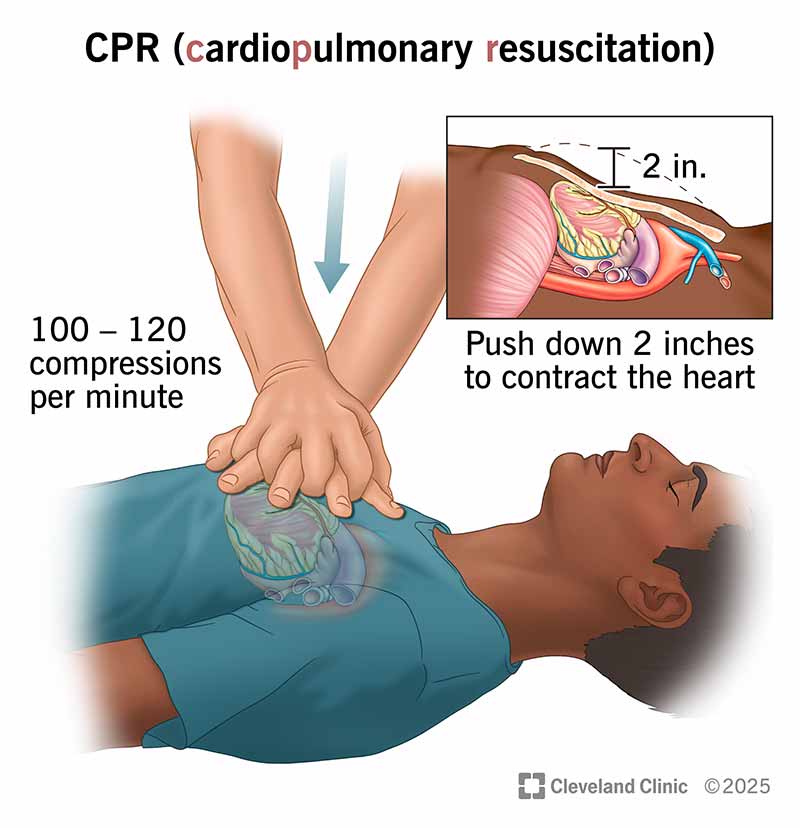CPR, or cardiopulmonary resuscitation, can help someone survive cardiac arrest. Even if you don’t know CPR, you can help someone by only doing chest compressions. To give the person the best odds of survival, you need to take immediate action. Start CPR while someone else calls 911 and looks for an AED (automated external defibrillator).
Advertisement
Cleveland Clinic is a non-profit academic medical center. Advertising on our site helps support our mission. We do not endorse non-Cleveland Clinic products or services. Policy

CPR stands for cardiopulmonary resuscitation. It’s a way to save the life of someone who’s in cardiac arrest (when their heart can’t pump blood). It’s an attempt to restart their heart and/or keep their blood circulating.
Advertisement
Cleveland Clinic is a non-profit academic medical center. Advertising on our site helps support our mission. We do not endorse non-Cleveland Clinic products or services. Policy
CPR is a technique that anyone can learn. The key part of CPR is chest compressions, which keep blood flowing to vital organs until a regular heartbeat returns. Giving rescue breaths brings more oxygen into the person with cardiac arrest.
A person of any age needs CPR if ALL of the following happens:
If you receive CPR immediately after you go into cardiac arrest, along with other timely emergency care, your chance of survival can double or even triple.
There are two main types of CPR:
Studies show that hands-only CPR can be as effective as CPR with breaths in the first few minutes during a cardiac arrest event for an adult. This is for scenarios outside of a hospital.
Before starting CPR, try to get medical help. Call 911 or your local emergency service number. The dispatcher can guide you through the CPR steps until paramedics arrive. Ask someone nearby to get an automated external defibrillator (AED).
Advertisement
Next, think of ABC to see if the person needs CPR:
Perform CPR if there’s no breathing and no pulse.
CPR consists of chest compressions and rescue breaths. You can only do chest compressions if that’s what you’re most comfortable with.
CPR starts with chest compressions:
While giving compressions:
Giving chest compressions can get very tiring very quickly. If other people are around, have them switch places with you to continue the compressions when you run out of energy.
It’s OK to only do chest compressions (hands-only CPR).
If you have CPR training, you can pause compressions to give the person two mouth-to-mouth rescue breaths. Give two breaths for every 30 compressions (about 20 seconds or so).
Keep doing chest compressions and giving rescue breaths in a cycle until the person revives or more help arrives.
While you’re doing CPR, someone should be bringing an AED to use to help with resuscitating the person.
Advertisement
During rescue breaths, you pause chest compressions for a few seconds. After two rescue breaths, you resume the chest compressions.
You should keep doing CPR until the person starts breathing or a paramedic arrives. If you get tired, another person can switch places with you.
CPR can save a person’s life if they receive it right after going into cardiac arrest. CPR can keep blood moving through a person’s body. This may prevent organ damage, like cerebral hypoxia.
About 1 in 4 people who get prompt CPR in a hospital survive and go home after a hospital stay. About 1 in 10 people who get CPR after a cardiac arrest in a non-hospital setting survive. Still, it’s worth attempting CPR when someone’s in cardiac arrest. The best odds happen with consistent CPR for as long as it takes.
CPR comes with risks because of how hard the chest compressions have to be to keep blood circulating. It’s possible to break ribs and injure organs within the chest during CPR. But this risk is worth it to try to save a person’s life.
Some people with certain preexisting health conditions might not experience the same benefits from CPR, depending on how sick they are before they go into cardiac arrest. If you have a significant or severe medical condition, consider speaking with a healthcare provider you trust about what your recovery or outlook might look like if you needed CPR.
Advertisement
After first responders take over caring for the person receiving CPR, they’ll get them to a hospital as soon as possible.
If the person survives, healthcare providers will check for any organ damage from a lack of oxygen. They’ll also determine the cause of cardiac arrest and provide whatever treatment the person needs. Having a cardiac arrest is a very significant event. The specific reason for it strongly influences the outcome of recovery.
Most cardiac arrests that happen outside a hospital happen at home. So, you could be helping a relative or friend if you know CPR. You may want to get training for CPR if you have a loved one at risk of cardiac arrest. That way, you’ll be ready if they need your help.
Even “hands-only CPR” can help a person stay alive until first responders arrive. CPR increases a person’s chance of surviving cardiac arrest, but it’s important to act quickly.
Advertisement
When your heart needs some help, the cardiology experts at Cleveland Clinic are here for you. We diagnose and treat the full spectrum of cardiovascular diseases.

Last reviewed on 03/03/2025.
Learn more about the Health Library and our editorial process.